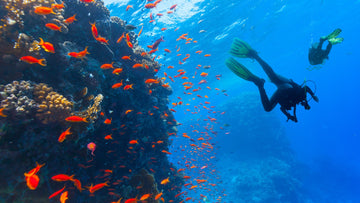Swimwear From the Ocean, For the Ocean: ECONYL Fabric for Swimwear
by Jenna Bricher
The apparel industry has a problem. In the quest for more sustainable options across all facets of life, 65% of textiles used in clothing are derived from fossil fuels. Synthetic fibers like polyester, nylon, spandex, and acrylic are all essentially wearable plastic fibers that have harmful effects on the environment. Unfortunately, as far as some sectors of the apparel industry are concerned, there isn’t a reasonable substitute for these materials – there’s a reason you’ve never seen a cotton or silk swimsuit. Luckily, there are a handful of companies creating more sustainable, earth-friendly, recycled textile options that are allowing us to reduce the negative impacts of apparel production.
ECONYL® is one of the companies working to create a closed-loop, or circular, supply chain in the nylon industry. The goal of such a supply chain is to create sustainable solutions where end use materials are recycled and once again converted to raw materials to extend their lifespan and reduce waste. The process used to create recycled nylon (like that used to create suits for Jenna Bricher Swim), uses a fraction of the energy that is used to create new nylon, saves tens of thousands of barrels of crude oil, and avoids substantial amounts of greenhouse gas emissions. In addition to all of that, when these synthetic materials are recycled, they are saved from becoming a permanent part of our ecosystem (I.e., dumped into a landfill or discarded in the ocean).
What’s the harm in synthetic fibers?
The biggest concern when it comes to these man-made fibers is that they don’t break down the way a natural material like cotton or silk would. When a polyester tee-shirt gets thrown away, it could take as long as 200 years to biodegrade. Beyond that, when people wear synthetic clothing, teeny-tiny, nearly invisible fibers shed off the surface of the garment – this is called microfiber shedding. Since the fibers don’t break down easily, they will find their ways into our rivers and oceans, they will be consumed by fish, that will be eaten by humans, and since our water processing plants can’t filter out these tiny particles, we will be drinking them, too. These plastic microfibers have literally become a part of our diet – yum, right?
What materials are recycled to create the renewed fabric?
This might come as a bit of a shock to you, but the buttery, beautiful fabric used to create Jenna Bricher Swimwear actually comes from a combination of recycled carpet, old fisherman’s nets, production scraps from other apparel lines, and recycled clothing acquired through take back programs. Aquafil (a company that deconstructs, sorts, and cleans fibers from old carpets) works hand-in-hand with the Healthy Seas Foundation (where volunteer fishers and divers recover old ghost nets from the ocean) to gather fibers to be regenerated into ECONYL® yarn. From there, these threads can be turned into anything from tents and rope, to hosiery and swimwear, with the final product being just as high quality as if it had been made from entirely new materials.
 Photo: used carpet and fishing nets getting ready to be recycled to be converted back into usable nylon
Photo: used carpet and fishing nets getting ready to be recycled to be converted back into usable nylon
As the world continues to make products that aren’t recyclable, compostable, or biodegradable, it is important to consider the materials of which our purchases are made. The age-old slogan, “reduce, reuse, recycle” is more relevant now than ever before, as we see both the land and the sea becoming home to our discarded possessions. Thankfully, companies like ECONYL® are working to reduce the negative human impact on the environment – contributing to less pollution and a healthier world for all of us. When you choose to support companies like Jenna Bricher Swim, you, too, have become a part of the global sustainability solution.
Thanks for reading,
Jenna Bricher, Owner, Jenna Bricher Swim




